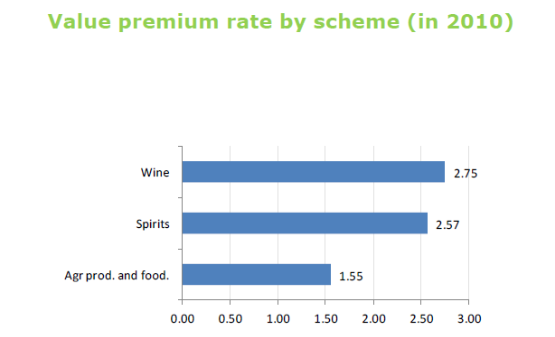GI wines deliver extreme benefits for the product, the local economy and marketing of the wines. In summary the following advantages have been recorded by implementing GI on wines:
- GI creates added value for the products – wines that have GI – PDO or PGI logo. Wines having GI logos are linked to particular places which are famous for the production of the specific wine due to cultivation techniques, varieties, know-how, tradition, etc which also manifests authenticity and for so perceived as high quality
- Wines with GI enjoy higher prices due to the added value created. Specifically, the European Commission (2012) in a study found that products protected by GIs in the EU are sold at a price 2.23 times higher than that of a similar product that does not have GI.
- The area regarding GI can be developed based on a production specialization model which in turn will lead marketing to be focused on specific features of the product and locality.
- The stronger the link between the wine and the geographical area, the more the customers associate the product to the area and the area appreciates economic rewards
- GI wines can be better differentiated from competitive wines or substitute products, as their features are clearly identifiable and their label – trademark protected from misuse or misleading
- GIs wines preserve local natural resources because they avert the standardisation of wine production. Therefore, GI wines and products are very significant for the agricultural sector as they focus on quality rather than quantity, motivate producers to focus on quality and enjoying higher incomes while also encouraging the diversification of agricultural production.
- GIs wines preserve local know-how because they keep the people at previously disadvantaged tourist areas and transmit from one generation to another the knowledge regarding cultivation and wine production and additionally promoting rural development.
- GI wines promote rural development additionally through avoid internal or external youth migration, driving to tourism increase, job creation, and transfer of the added value of the wine to the geographical area the wine is produced at.
- GIs contribute not only to the reputation of the product but to the reputation of the area of origin of the GI wine product. Thus, there is a bidirectional relationship between reputation and geographical area of origin of the wine. Moreover, GI wines raise local and national identity of stakeholders of the wine production.
- GIs guarantee that producers will offer to their customers exceptional products standing up to their reputation.
- GIs are used as a marketing tool since GIs are closely related to trademarks since they both indicate product origin. Also, products with GI have reputation for quality associated with place name used on labels, marketing and advertising is more efficient and GI wines are immediately recognized by consumers.
- GIs forms the concept of Terroir (an interactive cultivated ecosystem, in a given place, including climate, soil and the vine). Terroir is an extremely significant concept in viticulture since it associates the sensory attributes of wine to the environment where the grapes are grown
- Strengthens export potentials

Figure 3: Value premium rate by scheme (in 2010); Nathan, 2018
